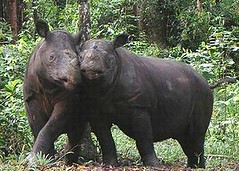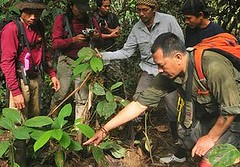 印尼和馬來西亞政府4日宣布將首次攜手合作,拯救極危險瀕臨絕種的蘇門答臘犀牛。蘇門答臘犀牛是亞洲數量最少也是最後一種兩角犀牛,已經在地球上存在超過兩千萬年。
印尼和馬來西亞政府4日宣布將首次攜手合作,拯救極危險瀕臨絕種的蘇門答臘犀牛。蘇門答臘犀牛是亞洲數量最少也是最後一種兩角犀牛,已經在地球上存在超過兩千萬年。
僅存的野生種蘇門答臘犀牛,學名是Dicerorhinus sumatrensis,總數量不到100隻,生活在印尼蘇門答臘島和婆羅洲島北部的馬來西亞領土。
在世界自然保育聯盟「物種存續委員會」(IUCNS-SSC)於新加坡動物園召開的蘇門答臘犀牛危機高峰會上,印尼和馬來西亞達成合作協議,許多國際性和國家級組織亦前來共襄盛舉。
會後,參與高峰會的專家學者旋即研擬出為期兩年的緊急應變計劃。兩國政府目前需要商討出因應蘇門答臘犀牛危機的下一步具體措施,解決非法狩獵和犀牛角的消費需求等讓蘇門答臘犀牛瀕危的因素。
在新加坡會議現場,全世界130多位關心蘇門答臘犀牛的專家、學者、官員和非政府組織代表見證下,沙巴野生動物保護部部長Datuk Laurentius Ambu詳細說明兩國針對保育蘇門答臘犀牛將採取的行動,他承諾「我們重申沙巴對犀牛保育的承諾,在進行蘇門答臘犀牛人工圈養繁殖計畫的同時,我們也願意和印尼進一步討論交換生殖細胞、交換個體、及應用最新繁殖技術的可能性。」
與會人員也參考過去別種犀牛和其他物種保育成功的案例,如加州兀鷹、黑腳貂和夏威夷林鳥等,研擬保育計劃。
「我們必須採取有效的行動來防止蘇門答臘犀牛滅絕。這可能是我們拯救這個物種的最後一個機會,只要我們有共同的願景和目標,跨國跨區域通力合作,就有成功的希望。讓我們團結一心,複製過去保育成功的經驗,並且消除各種阻礙保育的因素。」非政府組織印尼犀牛基金會執行長Widodo Ramano說。
「蘇門答臘犀牛危機高峰會是一個意義重大的轉捩點,兩國代表承諾主動積極的雙邊合作,對拯救瀕危物種來說非常重要。」IUCN SSC物種保育計劃委員會主委Mark Stanley Price表示,「改善犀牛田野調查、保全和監測所需的資源方面已取得重大進展。我們也發現有機會應用在野生和人工圈養管理的新科技。」
儘管近年犀牛的處境相當不樂觀──2010年起,已經有兩個犀牛亞種絕種,分別是喀麥隆的西部黑犀牛(Diceros bicornis longipes)和越南的印尼爪哇犀牛(Rhinoceros sondaicus annamiticus),高峰會達成的協議還是讓與會者們大受鼓舞。
蘇門答臘犀牛危機高峰會是由新加坡野生動物保育集團主辦,森那美基金會(Sime Darby Foundation)、世界自然基金會(WWF)、IUCN SSC、國際犀牛基金會(International Rhino Foundation)、印尼動物園協會(Association of Zoos Se Indonesia)和印尼Taman Safari Indonesia動物園出資贊助。
 3月底,WWF印尼分會傳出生態喜訊,其野外調查小組於今年稍早在婆羅洲島進行紅毛猩猩野外調查時,在婆羅洲中心地帶東加里曼丹的WWF保育區-Kubar地區發現犀牛蹤跡。WWF印尼分會犀牛專家和印尼穆拉哇曼大學野生動物研究員Chandradewana Boer博士證實,很有可能是蘇門答臘犀牛。
3月底,WWF印尼分會傳出生態喜訊,其野外調查小組於今年稍早在婆羅洲島進行紅毛猩猩野外調查時,在婆羅洲中心地帶東加里曼丹的WWF保育區-Kubar地區發現犀牛蹤跡。WWF印尼分會犀牛專家和印尼穆拉哇曼大學野生動物研究員Chandradewana Boer博士證實,很有可能是蘇門答臘犀牛。
這個消息振奮了國際生態保育界,因為該地區過去從未發現蘇門答臘犀牛。
「這個發現對全世界,尤其是印尼保育界來說非常重要,因為這是首次記錄到蘇門答臘犀牛出現在東加里曼丹和Kubar地區。」印尼林業部生物多樣性保育主任Bambang Novianto指出,「這項資訊對於保育僅存犀牛和發展犀牛棲息地來說有很珍貴的價值。」他也表示,保育婆羅洲的蘇門答臘犀牛需要當地社群、企業和各界的合作,採取適當措施。
WWF印尼分會主任 Nazir Foead表示,「WWF印尼分會和相關組織,包括林業部和Kubar當地政府,將會進行更全面性的追蹤調查,找出西Kutai地區中的犀牛棲息地和犀牛群,」並根據調查的結果研擬保育策略和計畫。他說明,「蘇門答臘犀牛保育行動是一場長期抗戰,需要可靠的資金協助。這些資金帶來好消息,也帶來了2012年6月5日印尼總統Susilo Bambang Yudhoyono宣布啓動國際犀牛年以來最重要的時刻。」
The governments of Indonesia and Malaysia today agreed for the first time to collaborate on saving the Critically Endangered Sumatran rhino, the smallest and last form of the two-horned rhino in Asia that has lived on the planet for 20 million years.
The last wild populations of Sumatran rhino, Dicerorhinus sumatrensis, amount to fewer than 100 rhinos in total. They survive on the Indonesian island of Sumatra and in Sabah, Malaysia on the northern part of the island of Borneo.
The agreement was reached at the Sumatran Rhino Crisis Summit convened by the International Union for Conservation of Nature's Species Survival Commission (IUCN SSC) at the Singapore Zoo with a wide range of international and national organizations.
Experts gathered at the summit proposed a two-year emergency action plan as an immediate follow-up to the event. The two governments now need to formalize the collaboration and agree on the next steps to tackle the Sumatran rhino crisis, brought on by an increase in illegal hunting and consumer demand for rhino horn.
Datuk Dr. Laurentius Ambu, director of the Sabah Wildlife Department, detailed some of the initiatives the two countries will take to conserve the last Sumatran rhinos.
"We would like to reiterate Sabah's commitment and our willingness to further discuss with Indonesia opportunities to exchange reproductive cells of the species, move individual rhinos between our countries and to employ advanced reproductive technology as a parallel initiative in the Sumatran rhino captive breeding program," he said.
Dr. Ambu made this pledge to more than 130 rhino experts, scientists, government officials and representatives of nongovernmental organizations from around the world gathered in Singapore this week to address the Sumatran rhino crisis.
They made their plans in view of lessons learned from previous conservation successes of other rhinos and species such as the Californian condor, the black-footed ferret and Hawaiian forest birds.
"Serious steps must be taken to roll back the tide of extinction of the Sumatran rhino," said Widodo Ramano, executive director of the Indonesian Rhino Foundation, Yayasan Badak Indonesia, a nongovernmental organization.
"This could be our last opportunity to save this species and, by working together as a collaborative unit, internationally and regionally, with an agreed vision and goals, a glimmer of hope has been clearly demonstrated," he said.
"We need to act together urgently, hand in hand, replicating some of the inspirational successes of other conservation efforts and aim to stop any failures that might impede progress," Ramano said.
"The Sumatran Rhino Crisis Summit has been transformational by bringing together the two governments whose representatives committed to positive and proactive bilateral collaboration which is critical for saving this enigmatic species," says Mark Stanley Price, chairman of the IUCN SSC Species Conservation Planning Sub-Committee.
"Huge progress has been made in specifying the resources needed to improve rhino surveys, security and monitoring," said Price. "We have also explored the potential of new technologies and the role of integrating the management of wild and captive individuals."
Summit participants were encouraged by the agreement, although the recent past history of rhinos has been bleak.
Since 2010, two rhino subspecies, the Western Black Rhinoceros, Diceros bicornis longipes, in Cameroon and the Indochinese Javan Rhinoceros, Rhinoceros sondaicus annamiticus, in Vietnam have gone extinct.
The Sumatran Rhino Crisis Summit was hosted by Wildlife Reserves Singapore Group, while Sime Darby Foundation, World Wildlife Fund, IUCN SSC, the International Rhino Foundation, the Association of Zoos Se Indonesia, and Taman Safari Indonesia provided funds and resources.
Those looking for positive signs of rhino survival got some good news last week when WWF-Indonesia announced that its monitoring team found traces of fresh rhino tracks earlier this year while monitoring orangutans on the island of Borneo.
The tracks were found in Kutai Barat, Kubar, East Kalimantan, in the Heart of Borneo, a WWF conservation area.
Rhino experts at WWF-Indonesia and wildlife researcher from the University Mulawarman Dr. Chandradewana Boer, confirmed that the species is likely the Sumatran rhino.
These findings bring fresh air to the world of national and international conservation, given that the presence of Sumatran rhinos has never been detected in this area of Borneo.
"This discovery is very important for the world, especially for the conservation of Indonesia, because it is a new record of Sumatran rhino presence in East Kalimantan, especially in the Kubar area," said Bambang Novianto, director of biodiversity conservation with Indonesia's Ministry of Forestry.
"This information is important for the existence of the protection of the population and development strategies in rhino habitat areas," said Bambang.
According to him, in the future, required the cooperation of many parties, including local communities, corporations, and others to take appropriate measures for the conservation of Sumatran rhino in Borneo.
WWF-Indonesia Conservation Director Nazir Foead, said, "WWF-Indonesia with related parties, including the Ministry of Forestry and Kubar government, will undertake a more comprehensive follow-up survey to map the rhino habitat preferences and population in West Kutai." Based on the results of the survey, strategies and action plans can be formulated.
"Sumatran rhino conservation efforts in Borneo will take long-term and sustainable funding support," said Nazir. "These findings bring good news and an important moment since the introduction of the International Year of the Rhinos last June 5, 2012 by Indonesian President Susilo Bambang Yudhoyono."
※ 全文及圖片詳見:ENS




